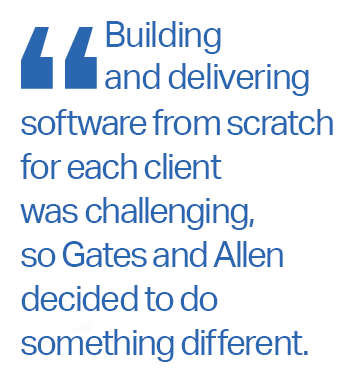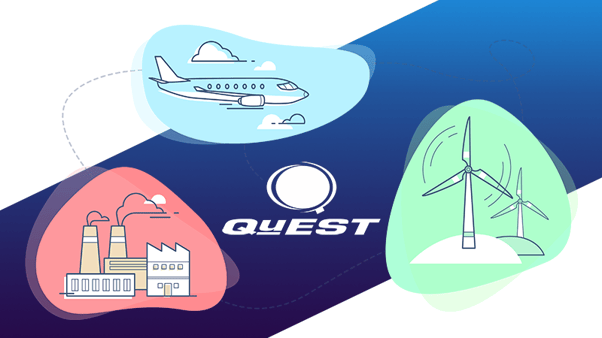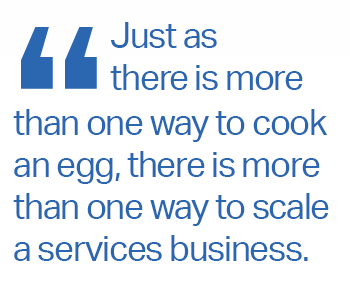Microsoft’s Secret to Scaling Services Businesses


Service businesses exist everywhere, and starting a service business usually doesn’t require a lot of capital.
But growing a services business is another cup of tea, as the owners of most mid-market services businesses know all too well.
Why?
One of the downsides of a service business lies in the very nature of services itself.
Services boil down to exchanging time for money, usually to one customer, or at most a handful of customers. For example, an architect gets paid to design a house for a single customer but can’t sell the same design to others. Similarly, a digital marketing consultant gets paid hourly to give advice to a single client.
Worse, each time a new service is delivered, whether a set of plans from an architect or a new social media strategy from a digital marketing agency, people are required to develop and deliver it.
Simply put, in most services businesses, getting more business means hiring more people. Economies of scale are typically not part of the deal! All this makes it very difficult for most services businesses to scale.
Finally, most services businesses lack the uniqueness and potential for astonishing growth that venture capital and private equity investors look for. For most, getting access to that kind of capital is out of the question.
So where, one might ask, might the cash come from to fund the growth that most mid-market companies can only dream about?
Happily, there’s a solution to these time-honored challenges: the service-to-product model that transforms services into marketable products that can stand and be delivered on their own.
If you are running a mid-market services business, this model and the customer funding it brings may well be your ticket to ramped-up growth.

We’ll begin exploring the service-to-product model by first looking into how Bill Gates and Paul Allen transitioned from selling software development services to one B2B customer at a time to selling software products in shrink-wrapped packages at Microsoft.
Microsoft’s Journey From Services
To Products

In 1975, Gates and Allen were building software operating systems for companies such as Ricoh, Texas Instruments, and others, all of which were bringing to market their then new-fangled personal computers at the dawn of the PC age.
Without operating systems, these early PCs were little more than fancy paperweights that couldn’t actually do very much. So Gates’ and Allen’s services business was doing well. At times, they were even paid up to $180,000 up-front, which Gates recalls as being “incredible”.
However, services take time to deliver and as they tried to keep up with the workload, Gates and Allen often ran into delivery challenges. Allen recalls, “We were so late that Ricoh finally flew a guy over whose whole job was to sit in our office day and night until we delivered.”
In 1980, IBM hired Gates’ and Allen’s young company, Microsoft, to build the operating system for the secret new “personal computer” that IBM was developing. Microsoft delivered PC-DOS to IBM, but the story doesn’t end there.
Having seen that the operating systems they had been building for their clients were remarkably similar, one to another, Gates and Allen decided to do something different. They structured the contract with IBM in such a way that permitted Microsoft to provide a copycat DOS for any future IBM PC copycats. MS-DOS was born.
Gates vividly remembers his thinking: “Our goal was not to make money directly from IBM, but to profit from licensing MS-DOS to computer companies that wanted to offer machines more or less compatible with the IBM PC.”
The beauty of MS-DOS was remarkable in its simplicity. No longer did Microsoft have to spend weeks or months writing code – a services business – for yet another operating system, as new entrants like Compaq and others jumped on the PC clone bandwagon. They simply licensed a product that could be shipped in a shrink-wrapped box or downloaded digitally.
As PC penetration grew, Microsoft began developing additional software products — Word, Excel, and more — that also came in shrink-wrapped boxes. These software products were not limited to just one PC maker, but any PC maker running on DOS.
Microsoft had successfully transformed their services into stand-alone products that could be sold to multiple customers without requiring additional time or hand-holding from Gates or Allen. The rest, as they say, is history.
From Typewriters & Carbon Paper to SaaS

In January 2000, Ángel Pérez returned to his native island, Puerto Rico, from the United States with experience in IT.
There, Pérez took a job running the small San Juan office of Rock Solid, a Texas-based provider of IT support for Microsoft products. The office and its five employees served a single Puerto Rican customer with a million-dollar service contract.
Pérez, always on the lookout for opportunity, saw the potential for the business to grow. By 2006, through strengthening and taking advantage of his company’s Microsoft certification and relationships, Pérez had built the Puerto Rican operation to 80 people.
The team was supporting mostly public sector clients who used Microsoft software, and sometimes others.
 Rock Solid was becoming known as the best place to go in Puerto Rico for IT services and support. But Pérez wanted more.
Rock Solid was becoming known as the best place to go in Puerto Rico for IT services and support. But Pérez wanted more.
In 2006, Pérez saw an opportunity to introduce IT systems into Puerto Rico’s 78 municipalities which were still operating with typewriters, carbon paper, and manual ledgers.
Pérez pursued this opportunity by securing a contract with the municipality of Coamo, a forward-looking city of some 30,000 inhabitants.
Coamo’s administrative staff quickly adapted to the new systems Rock Solid developed and supported, and citizens and staff alike quickly noticed the results in the municipal’s greater ease and speed in getting work done, alongside greater responsiveness to the community’s needs. Rock Solid soon won a reputation for adapting ERP and CRM systems to municipal settings.
However, Pérez realized that offering implementation support as a service was holding his company back. If Rock Solid limited itself to being a service provider that simply implemented new IT systems, the municipalities would still need to do a lot of things on their own, such as sourcing PCs, servers, cabling, and power backup.
Rock Solid, too, had to hire more developers every time it won a new client. There had to be a better way. With the arrival of cloud computing, Pérez found his answer.
With the arrival of cloud computing, Pérez found his answer.
He would transform the services his team was delivering into a SaaS product that future customers could simply run from the cloud. This meant no servers, no cabling, and no permanent IT staff were needed for municipalities to switch to new systems. City employees would simply log into their internet connections to access the systems.
This worked out well for Pérez, too, because winning operating contracts required far less bureaucracy than tendering for major capital expenditure projects. Even better, no new developers were required at Rock Solid’s end when new clients came on board.
By late 2013, Rock Solid had signed up more than a third of Puerto Rico’s 78 municipalities and had also secured similar customers elsewhere in Latin America. The company’s profitability and cash flow soared.
The service-to-product transition and the subscription payments for Rock Solid’s SaaS products had turned Rock Solid into a customer-funded and highly profitable growth machine.
Can Service Businesses Scale Without Transitioning To Products?

Just as there is more than one way to cook an egg, there is more than one way to scale a services business – sometimes.
That’s what QuEST Global Services, a fast-growing provider of outsourced engineering services, has done.
Ajit Prabhu and Aravind Melligeri started QuEST in upstate New York in 1997. Prabhu was doing part-time engineering work for General Electric’s (GE) Corporate Research and Development Center while studying for his PhD. He felt he could do a better job sourcing talent for GE than GE was doing on its own. He began providing this service to GE, sourcing talent primarily among his fellow engineering students.
In 1998, Melligeri suggested that India could be a source of additional talent at a lower cost. So the duo opened an office in Bangalore.
The business model was compelling, with GE paying $90 per hour and QuEST paying its Indian engineers about $5 her hour. Thanks to the world’s rapidly increasing thirst for energy, and the fact that GE was a leading supplier of gas turbines for power plants, QuEST grew quickly.
Just by providing these outsourcing services, QuEST hit $5 million in annual sales by their year end of March 2001 and $14 million by March 2002. GE accounted for about 80% of QuEST’s sales.
Then, in February 2003, GE announced it was opening an engineering center in India and that it would take back all of its outsourced engineering activity. Prabhu and Melligeri were stunned.
Having lost their biggest source of projects, QuEST’s revenues plummeted. Having foreseen the risk of having most of QuEST’s eggs in GE’s basket, Melligeri had already struck a deal with The Carlyle Group, which agreed to a $6 million investment for a 23% stake. Using QuEST’s already formidable track record for first-rate service delivery and funds from Carlyle, Prabhu quickly set about finding new clients.
Soon, Prabhu closed a deal with Rolls Royce. EADS and United Technologies followed. In 2004–2005, QuEST’s top line recovered to $19.6 million, and it jumped to $25.8 million in 2005–2006. Profitability rebounded, too, from a $3.5 million loss in the difficult year of 2003–2004 to profit of $2.5 million and $3.8 million in 2004–2005 and 2005–2006.
Fast forwarding to today, QuEST has become one of the world’s premier providers of outsourced engineering services, with revenues having surpassed the $500 million mark.
Growth in a services business like engineering outsourcing, as we’ve seen, means hiring more and more engineers. How has that growth been funded, one might ask? With round after round of growth capital from private equity players.
Why has QuEST been able to access the capital markets when so many services business cannot?
Margins, for one: $90 per hour revenue for labor that cost $5 early-on. A unique opportunity that took advantage of a shortage of engineering talent in the developed world. QuEST’s ability to access Indian engineers filled that gap. And, last but not least, Prabhu’s and Melligeri’s superb execution.
The Advantage Of Using Customer’s Funds To Scale A Service Business
From these case studies, we can come to three conclusions.
- There are multiple ways to scale a service business. Microsoft turned their software services into products. Rock Solid turned their IT services into SaaS.
QuEST relied on external funding to secure major clients and scale, although this path did mean they had to surrender a significant stake in their business to outside investors. Investor relations can sometimes turn rocky. - Transforming your services business to a product business is a customer-funded approach that can give you the freedom to scale without having to rely on external funding.
After all, isn’t freedom a key reason why you’ve chosen to own and operate your own mid-market company? - Product businesses are often more scalable than services businesses, which require so many more people as they grow that they often lack any meaningful economies of scale.
Being bigger for its own sake, and having to attract and manage many more people, may not be what you want.
So, whether you’re a budding entrepreneur or someone running an established services business, making a service-to-product transition in your company can be advantageous.
If you'd like to build out your own customer-funded business, be sure to check out the program, Scaling Your Company Without Venture Capital - Master Business Course.



